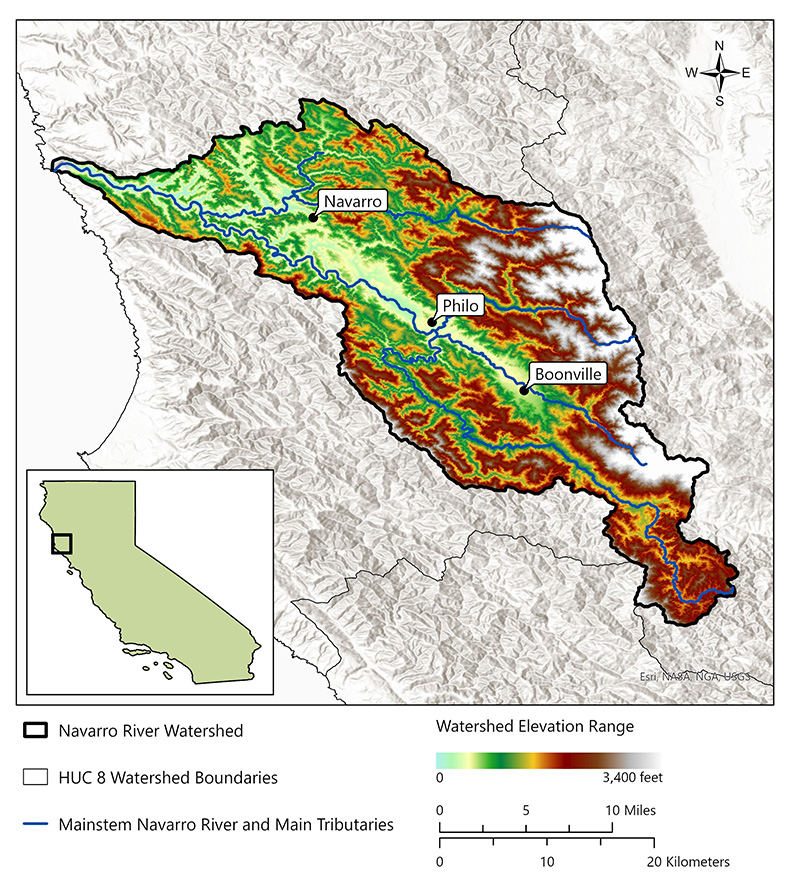
Supply and Demand Assessment (SDA) – Navarro River
Overview
The Navarro River Watershed is the largest coastal watershed in Mendocino County. It encompasses approximately 200,000 acres and ranges in elevation from sea level to over 3,000 feet. The area is sparsely populated and comprised of mostly forestland, rangeland, and agriculture. Water use in this region is characterized by numerous small diversions that support domestic uses and various interests such as viticulture, orchards, and grazing. The Navarro River is largely a natural river, with no dams or large reservoirs on the mainstem. It is also home to important spawning grounds for anadromous fish, particularly coho salmon and steelhead trout, both listed as threatened species under the federal Endangered Species Act (ESA). Primary water issues include low summer flows, excessive sediment concentrations, and high temperatures. The degradation of water conditions in the Navarro River and its tributaries led to the inclusion of the Navarro River in the Clean Water Act 303(d) list for impairments associated with sediment and temperature.
Announcements
August 26, 2025 - DRAFT Navarro River Model Development Report - Now Available
The model development report from Paradigm Environmental for the Navarro River water supply model is now publicly available in Model Development section below. Please email questions regarding the model development to DWR-SDA@waterboards.ca.gov.
Model Development
Outreach and Engagement
- Navarro River Watershed Fact Sheet
- Navarro River Local Meeting Presentation Slides
- Navarro River Local Meeting – Flyer Available
Tuesday, October 1, 2024, from 12:30 to 1:30 pm
Anderson Valley CSD Office, 14281 HWY 128, Boonville, CA 95415
Modeling in the Navarro River Watershed
The SDA Unit has continued to work on the models and tools developed for the Russian River Watershed during the State Water Board's 2021-2022 Regional Drought Response. These tools provided the necessary information for the Division of Water Rights (Division) to assess water availability and issue water right curtailments to ensure adequate, minimal water supplies for critical purposes under the emergency regulation.
To capture the water demand in the SDA Program Watersheds, water right demand estimates were incorporated based on information from annual reports of water diversion and use submitted to the Division. The SDA Unit continued to develop the Division’s demand dataset methodology and converted it into a series of R scripts and manual review spreadsheets that apply data quality correction flags. For example, the scripts identified and corrected unit conversion errors, duplicate reporting, and misplotted points of diversion. The SDA Unit then uses a water allocation tool adopted from the UC Davis Drought Water Rights Allocation Tool (DWRAT) to allocate available supply amongst water right holders based on their respective water right priority and water demands. This version of DWRAT allocates water at the subbasin level and accounts for imported flows.
The SDA Unit’s demand methodology, along with the supply scripts and the watershed specific versions of DWRAT, will be made available on the California Water Board Data Center GitHub page as separate repositories.
Additional Resources
Supply and Demand Assessment Program Links
Stay Informed
Email Subscription List
Subscribe to the SDA Information email topic to receive notifications and the latest updates.
Contact Us
If you have questions or please email them to: DWR-SDA@waterboards.ca.gov



